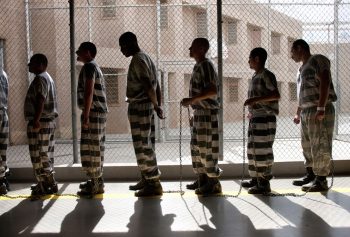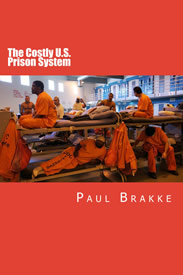 One out of every 32 Americans — approximately 7.2 million adults as of this writing — is on probation, on parole, or in prison at any given time.
One out of every 32 Americans — approximately 7.2 million adults as of this writing — is on probation, on parole, or in prison at any given time.
About 2.3 million Americans are in prison, nearly one in one hundred adults. Our country has the highest rate of incarceration in the world — higher than Russia, China, or Iran. It is eight times higher than the rate in Germany. And it’s eight times higher than we had ourselves thirty years ago. We’ll never be able to make America great again if we don’t fix this problem. Who realized this was happening? Very few of us. This high rate of incarceration was also news to me.
To most of us, prisons are invisible. It’s enormously expensive to incarcerate so many people. In 2010, it cost between $14,603 and $60,076 per prisoner per year, depending on the state, and therefore these expenses need to be managed with as little waste as possible. Often, state and federal governments are poor stewards of taxpayer dollars. The costs of incarceration, parole, and probation in the corrections “industry” amount to over $70 billion annually. This amount is as much as the food stamp program.
This clearly is an expensive proposition the U.S. can’t afford, given a debt in the trillions and a need to raise the debt ceiling, or the U.S. will go broke and default on its debts, creating a world-wide crisis. State governments are strapped and increasingly concerned with the costs of incarcerating so many. How did we get to this point? One among many contributors has been the war on drugs.
The Deleterious Effects of the War on Drugs
The drug war is taking money from budgets that could be better spent elsewhere. There are perverse incentives in the system to keep this costly war going. For example, the officer who makes drug arrests gets overtime for doing the paperwork for each arrest. As a result, he can make many more arrests than an investigator who spends more time solving a homicide case. Thus, the cop who pursues the drug arrests is the one who gets promoted. Worse yet, we haven’t been able to stop drug smuggling, and the opioid crisis has resulted in the deaths of tens of thousands from overdoses.
Disproportionate Effects on Minority Communities in Our Cities
A serious side effect of the war on drugs has been the unintended societal effects on minority communities. Mass incarceration has truly blighted our inner cities and their minority inhabitants. While the majority of illegal drug users and dealers throughout the U.S. are white, three-fourths of all the people incarcerated for drug offenses are African-Americans and Latinos.
In 2006, one in nine 20-35 year-old black men was behind bars, and far more were on probation or parole. In 2000, 22 times as many Latinos and 26 times as many African-Americans were imprisoned for drug offenses as in 1983. The consequences of these high arrest and conviction rates are that African-American males are seven times more likely to be incarcerated than white males.
As a result, one out of fifteen African-American men are in prison, compared to one out of thirty-six Hispanic men and one out of 106 white men. Shockingly, one in three black men will spend some time in prison during the course of their lifetime. That wrecks the black family structure, since it leaves the family without a provider and with young black males lacking a good male role model to help them grow up to become good citizens. This high incarceration rate for African-American males thus perpetuates crime in the black community.
Something, obviously, is awry in America — one of the most “developed” countries in the world! What can we do about it?
Suggested Solutions
Serious reform is needed for the prisons and criminal justice system. This certainly won’t be an easy fix, but there are ways that it is possible to reduce both the devastation for individuals and families and the economic costs to society. How can we fix the system?
- Set up more re-entry centers to house prisoners in their last six months of incarceration. Many states have already set some up. These re-entry centers can reduce the staggeringly high recidivism rate, whereby two thirds of those released wind up re-arrested within three years. These centers can train prisoners in life skills, handling finances, and job procurement at only about half the cost of a state’s prison.
- Stop sending back to prison parolees who have committed only minor technical violations of parole. Such a change might go a long way towards lowering the high recidivism rate for felons, and thus ultimately reduce violence on our streets and the high prison population. Again, less violence and a smaller prison population mean less financial drain on society.
- Abolish mandatory minimum sentencing for nonviolent drug cases. This could reduce the prison population by several hundred thousand. While Attorney General Sessions does not appear to be in favor, mandatory minimum sentencing is primarily a state and local issue, not a federal one, since most prisoners are in state facilities.
- By reducing the enormous costs of incarcerating prisoners who do not require imprisonment, funds can be released for many other worthwhile programs at the federal and state level. This can include federal and state courts, both currently in serious financial difficulty and unable to provide speedy trials.
- Reform the bail system to reduce jail overpopulation by low flight risk individuals awaiting court dates from our seriously glutted court system.
- Work toward reducing our over 95% reliance on the plea bargain system, which penalizes those who cannot afford to hire a lawyer or to bail themselves out of jail while awaiting trial.
- Many additional suggestions may be found in my book: The Costly U.S. Prison System: Too Costly in Dollars, National Prestige and Lives.




